Edmond J. Safra Family Lodge opens
By Kathryn Boswell
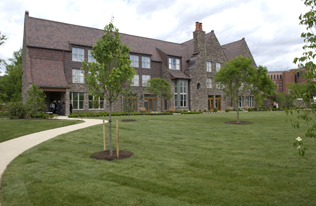
|
A view of the completed Safra Family Lodge and healing garden.
|
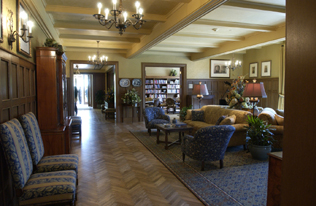
|
The Safra Family Lodge's lobby area is complete with fireplace, library and business center.
|
On May 26, 2005, the Edmond J. Safra Family Lodge opened to a well-deserved amount of fanfare and celebration. With celebrities, politicians, donors and NIH administrators and staff on hand to mark the occasion, the six-year planning and construction project officially came to an end as the Family Lodge was formally dedicated and opened.
Landscapers, construction workers, and Lodge staff labored to the last minute to ensure that every detail was completed to perfection for the day's event. And it was. Each newly planted hydrangea bush was soaking up the sunshine in the Lodge's healing garden while the lobby's wood floors gleamed as visitors were led on tours through the facility.
When Lily Safra, widow of the financier and philanthropist Edmond J. Safra and supporter of the Family Lodge project, saw the completed building for the first time she smiled and simply stated, "Beautiful."
As the guests mingled beforehand, Patient Advisory Group members Susan Butler and Ellen Berty chatted with other former patients and advisory group members. "We were here for the Lodge groundbreaking [on October 29, 2002]," said Butler. "Now here we all are again and it is finished," exclaimed Berty.
The opening ceremony was led by Barbara Harrison, news anchor for WRC-TV NBC 4, and featured speakers Dr. Charles A. Sanders, chairman of the Foundation for NIH Board of Directors; Dr. Elias Zerhouni, director, NIH; Hon. Paul G. Rogers, Lily Safra, and Dr. John I. Gallin.
In response to a growing need for a home away from home for the families of Clinical Center patients, the Foundation for the National Institutes of Health coordinated the important project with the generous support of the Edmond J. Safra Philanthropic Foundation and Lily Safra along with other contributors.
Gallin told the audience of how the Safra Lodge developed from a plan to a reality over the years. In the past, families of Clinical Center patients would stay in family homes or hotels while they waited for a loved one to complete treatment. The distance and cost took its toll on families. "The Clinical Center had a dream. The dream was to create a refuge for patient families; to relieve the stress of dealing with a severely ill loved one far from home," said Gallin. The idea of an on-campus guest house was proposed and put into action in 1996 in the form of six apartments in an NIH campus building. "The guest house was an instant success. It was fully occupied and proved the need for a home away from home for patients and their families. This place represents a powerful statement of our renewed commitment to our patients."
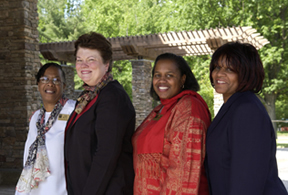
|
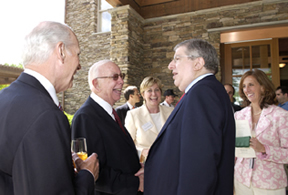
|
From left to right: Safra Lodge staff Annie Williams, Margo Bradford, Dilcia Stephens-Medley and Ellen Williams.
|
(l to r) Dr. Charles Sanders, chairman of the Foundation for NIH Board of Directors; Paul G. Rogers, former congressman (FL); Amy McGuire, director of the Foundation for NIH; Marvin Hamlisch, music composer; and Maureen Gormley, chief operating officer, CC.
|
Each speaker highlighted the unique spaces throughout the Family Lodge that will serve families, whether it will be a quiet garden place to reflect, a comfortable room in which to relax or a spacious kitchen to cook homemade meals-the entire facility will provide a much-needed home for those in need. It will also be a financial relief for families who can stay in the Lodge at no cost.
"When you need solitude, you will find it at the Safra Lodge. When you need to gather with others who share your pain, you will be able to do it at the Safra Lodge," said Zerhouni.
The Honorable Paul G. Rogers, a former Florida congressman (1955-1978), who is well known for his support of government funding for scientific research, said, "How graceful, welcoming and reassuring to have this building here. The Safra Lodge is the fruit of public and private understanding; it is a leading example of that successful partnership."
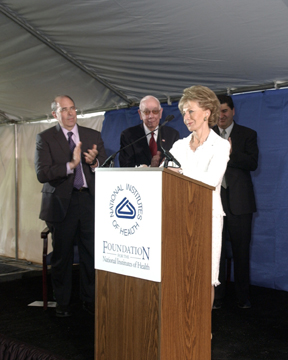
|
Lily Safra receives a standing ovation at the Safra Family Lodge opening ceremony.
|
When Mrs. Safra took the stage she was greeted with a standing ovation. "From personal experience, when a loved one becomes sick, the world narrows. Caring for them becomes not the most important goal, but the only goal," said Mrs. Safra, whose husband suffered from Parkinson's disease. "The Lodge will help us ensure that every patient at NIH will feel loved and cared for by the most important people in the world-their families."
The celebration continued late into the evening as Mrs. Safra hosted a party at the Library of Congress for 100 friends and donors including writer Peggy Noonan, French Ambassador Jean-David Levitte, lawyer and former White House advisor Vernon Jordan, and Ethel Kennedy.
Built in the English Arts and Crafts style, the Safra Family Lodge provides a home-like retreat by offering space for solitude, family meetings, and supportive fellowship. Located steps away from the NIH Clinical Center, the Lodge features 34 guest rooms, a library, business and telecommuting center, fitness center, home-style kitchen, and comfortable social and sitting areas. The surrounding gardens include a patio, walking paths and benches.
"This project had a heart," said Jan Weymouth, executive director of the Family Lodge. "It is not just a building, but a living, breathing place. It has impacted every person who has worked here."
Weymouth tells of the many individuals who committed themselves to the construction and opening of the Lodge. From the construction workers, to Inez Austin, the interior designer, to the Lodge staff-the project became a labor of love for many. "For all of us, it was an opportunity to build something important-a place with longevity and an important mission."
To view more photos of the Safra Family Lodge and to read more about the construction, design and founding contributors, visit http://clinicalcenter.nih.gov/familylodge/.
Back to Top
Clinical Center Art Series
Familiar images adorn Hatfield Clinical Center walls
Walk into most clinics or hospitals and you will be greeted with plenty of "corporate art." You know the type. The photograph of a butterfly with the word, "Change," emblazoned at the bottom. Or perhaps it is a sun-bleached poster-print of something that purports to be impressionism.
The artwork displayed throughout the Clinical Center, however, is nothing of the sort. There are exhibit spaces throughout the building that make visitors and passersby stop in their tracks, mesmerized by the color, detail, message and splendor. Every piece seems to naturally fit the space in which it is hanging or displayed and is uniquely relevant to the patients and staff that wait and work nearby. This is no accident-thanks to two women who labor tirelessly to bring culture and beauty to the halls of the Clinical Center. Crystal Parmele and Lillian Fitzgerald work in the Clinical Center Office of Facilities Management. Surrounded by offices full of blueprints and tools, their shared space is an island of vivid paintings, rolled canvases, and glass sculptures.
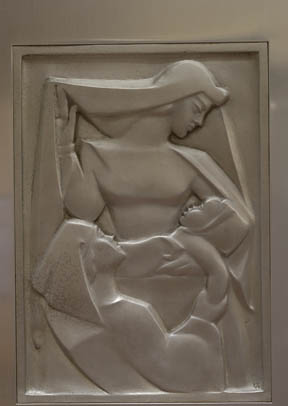
|
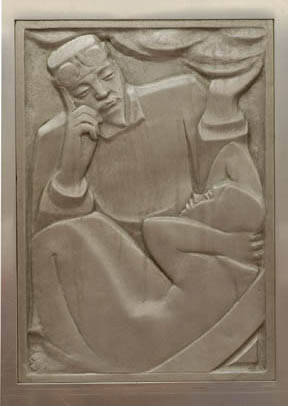
|
Metal plaques depicting Dorothea Lynde Dix (l), a pioneer in improved care for the insane, teaching a student nurse how to care for a child, and Dr. Sigmund Freud (r) "pushing the clouds" from a patient's mind. Both are metal castings from the Magnuson Center's main elevator doors, which have been recreated as wall murals in the P1 lobby.
|
Both artists in their own right, Parmele and Fitzgerald seek out local and international artists' works to display in rotating exhibit spaces throughout the Clinical Center as well as commission original works of art especially for the facility. When they find something they feel is a natural fit, they determine what pieces should go where, taking into account the size of the space and the environment in which it will be located.
Their latest and most challenging assignment was to find something to fill the walls of the P1 lobby in the new Hatfield Clinical Center. "Initially we didn't know what to do with the space," Fitzgerald says. "The walls are curved, which makes it particularly challenging. So we considered hanging banners for a time." But one day, as the two were having coffee together, Parmele had what she calls her "Eureka moment."
Parmele had continually come back to the images on the elevator doors in the Clinical Center's original main lobby. The metal castings had been installed in 1953 with the opening of the Magnuson building and depicted symbolic moments in medical progress. Designed by Russian-American artist Vincent Glinksy, the images are a priceless and beautifully detailed piece of NIH history.
However, Parmele had been struggling with how to translate those images into something that would be large enough to fill the large walls, without looking too dark or gothic. She figured out the solution was a wall covering.
Immediately the two went to work with C.M. Beavan and Associates where Chuck Beavan began to piece together the technology, concept and product plans. When they proposed the idea to the CRC activation steering committee as a part of their overall art installation plan for the Hatfield Center the response was very supportive. "I believe we were the first people to ever receive an ovation at the steering committee," Parmele laughs.
The project was then handed to Digital Arts Technology, Inc., where artist Rachael Scandarion fine-tuned and printed the final product, incorporating the warm colors and three-dimensional imagery that Parmele and Fitzgerald had been looking for. In May 2005, the printed wall murals were hung in the P1 lobby.
"The reliefs are a dramatic yet subtle integration of the old and new buildings," says Dr. John Gallin, Clinical Center director. "Lillian Fitzgerald and Crystal Parmele are to be congratulated for the innovative use of the images on the elevator doors in the lobby of the Magnuson building to create a spectacular presentation for the new Hatfield Clinical Research Center. These beautiful images serve as a distraction from the pain and suffering associated with illness and help all who walk our halls focus on the hope that is offered by the work being done at the Clinical Center."
"There is a real movement taking place in the arts and healthcare worlds," Fitzgerald says. "We are coming from a concept of cleanliness, where hospital administrators thought hospitals needed to look clean and sterile and we have moved into something more comfortable and inviting," Parmele continues.
Parmele and Fitzgerald have a number of other projects in the works. To read more about their other exhibits and the upcoming summer concert series, look for future issues of the Clinical Center News as we continue a multi-part series on the art of the Clinical Center.
- Kathryn Boswell
Back to Top
Angel Flight helps patients in need
By Kathryn Boswell
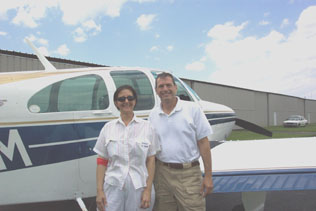
|
Patient Joyce Olson returns home to New Jersey with Angel Flight pilot Steve Inkellis in Inkellis' Bonanza 33.
|
For families seeking hope in the midst of a medical battle, being accepted into a Clinical Center trial can be the answer. However, there are many challenges for families in that process, primarily the obstacle of cost.
Many patients must travel great distances to come to the Clinical Center, and in some cases travel costs are not covered by NIH. Therefore, the price of airfare keeps many potential patients from pursuing the care and research they so desperately need. Angel Flight's mission is to make sure that does not happen.
Angel Flight is a nonprofit organization that transports families to medical facilities with the help of volunteer pilots who donate their time, fuel cost and the use of their private planes.
With six different Angel Flight regions across the country and 6,200 volunteer pilots on their roster, Angel Flight can pick up patients and their families at an airport close to their homes and fly them, at no cost, to a hospital or treatment center like NIH. According to their web site, Angel Flight's mission is "to ensure that no financially needy patient is denied access to distant specialized medical evaluation, diagnosis, treatment, or rehabilitation for lack of a means of long-distance medical air transportation."
Most patients find Angel Flight through their own research, and have to make all the arrangements themselves. At NIH, however, the Clinical Center maintains its commitment to serving the whole patient by offering on-site assistance for Angel Flight travel arrangements. Dr. William A. Gahl, intramural clinical director of NHGRI, was instrumental in bringing Angel Flight to NIH. In 2003, the Office of Rare Diseases and NHGRI partnered to offer this service to the entire NIH community at no charge.
"The Angel Flight program helps patients by offering services that are unavailable through other means," Gahl says. "Patients traveling through Angel Flight can often bring along family members that would otherwise not be covered. They can use oxygen on the flights, which is quite difficult for commercial airlines. The service is personalized, and the use of smaller airports saves time and adds an element of congeniality to the process."
Marita Eddy who works in the National Human Genome Research Institute offices (NHGRI) is the on-site transportation coordinator and is responsible for reviewing patients' travel needs and making the necessary arrangements with Angel Flight's Mid-Atlantic headquarters.
Eddy has 14 colored pushpins scattered across the eastern portion of the United States map that occupies her office wall. Each pin represents a patient who will be traveling to NIH over the next two months. "If a patient is able to climb into a small plane, needs financial assistance and is eligible for care at NIH, then I will contact Angel Flight and they will send the message out to their pilots," explains Eddy.
For some traveling patients, there is fear associated with traveling on a small airplane, but Eddy is available to calm their fears. She talks to them about what the flight will be like, that it will be bumpier than what they are used to, and she visits with them once they have arrived at NIH to find out how the flight went. The pilots also play an important role in making the patient feel comfortable. "We have one husband and wife flying team where the husband flies and the wife brings each patient a small, hand-made quilt," Eddy says. "It is just one of the many benefits of flying with Angel Flight," she continues. "It is closer to home, it's not crowded and you get personal help and service. When you land, there is even someone there to drive you to the hospital if you need it."
Eddy not only coordinates flights with Angel Flight, she also manages a group called Earth Angels that drive patients and their families to and from the airport and anywhere else they might need to go.
"I am convinced that all people want to help," Eddy says. "They just don't know how or they don't know what they have to give. Perhaps it's an automobile, an airplane or just a few minutes of their time."
Back to Top
Housekeeping employee honored for 50 years of service
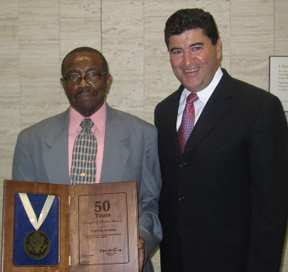
|
Clifford Thomas (left) is joined by Dr. Elias Zerhouni at the HHS Secretary's Departmental Honor Awards.
|
It has been said that no one is perfect, but there are some people who come pretty close. According to Henry D. Primas, chief of the Clinical Center's Housekeeping & Fabric Care Department, housekeeping aid Clifford Thomas is one of those people.
Thomas began working at NIH in 1955 after being honorably discharged from the Army as a member of the infantry at Ft. Meade. Now, after 50 years of serving the Clinical Center, he says he has no plans to retire.
"Rockville Pike was just a three-lane road back then," recalls Thomas, now 75. "I used to drive by and see NIH and I wondered if I could get a job there."
He was offered a job as a housekeeping aid, a position he still holds today. He has been cleaning in various places on campus for 50 years and on May 25, 2005, at the HHS Secretary's Departmental Honor Awards, he received his 50-year pin and a hearty handshake from HHS Secretary Michael Leavitt and NIH Director Dr. Elias Zerhouni. Thomas has also been busy spending time with his wife Robby Mae and eight grown children.
"Mr. Thomas is a very rare person," says Primas, who has known him for a decade. "He's very dependable, having a large cache of sick leave that he seldom uses, and if he says he's going to do something, he does it. He gets along with everyone and puts in a full day's work and is very pleasant and courteous."
When asked if he had plans to retire any time soon, Thomas shakes his head. "I never even think about it," he says.
His greatest joy during his 50 years on campus is that each day that he has a job and is able to work. "Everything is a great moment," he says.
Thomas, who works to keep things clean on the Clinical Center director's floor, was specifically requested by the staff in that office to follow them to the sixth floor after the move to the CRC.
"Mr. Clifford is one of those rare individuals who distinguish themselves through their actions and reliability," says Clinical Center Director Dr. John I. Gallin. "He's remarkably dedicated, efficient, pleasant, unobtrusive-and that he's decided to stay on with us for so many years is certainly fortunate for us. His work ethic and values are greatly appreciated."
In the meantime, Thomas says he is looking forward to working for many more years to come. And if he ever decides to retire, he will be sorely missed.
- John Iler
Back to Top
Red Cross volunteer Fae Allen
30 years of serving the Clinical Center
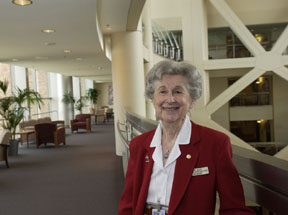
|
Fae Allen has been a Red Cross volunteer for 50 years, 30 years of that time has been spent at the Clinical Center.
|
When Fae Allen's father went to the hospital for brain surgery to remove a tumor, he spent many months under the watchful care of the nurses there.
On the day he was released from the hospital, Allen smiled back at the faces of those who had cared for her and her father with such loving sincerity, she knew that she wanted to give something back. So began a 50-year relationship with the Red Cross.
Today, 86-year-old Allen is still hard at work as a Red Cross volunteer. She remembers the rigorous training from her early days as a volunteer as well as the little white cap that used to be a standard part of the Red Cross uniform-something she is happy to say is no longer a required accessory. After 20 years of service in her home state of Pennsylvania, Allen and her husband Don, who passed away last year, moved to the Washington, D.C., area and she began volunteering at NIH, which she has continued for 30 years.
In April 2005, Allen was one of the many NIH volunteers who were honored at a Red Cross recognition ceremony for her 50 years of service.
Allen, who works as a patient representative and Red Cross volunteer at NIH's Clinical Center says, "The best I can do is to make someone feel comfortable and to let them know that someone is here on their behalf."
Patient representative Laura Cearnal who works with Allen says she is an inspiration to her and all the other volunteers. "Fae is a remarkable woman," Cearnal says. "I always make sure that our new volunteers spend at least day with her so they can learn from her." Cearnal is also impressed with Allen's dedication and tenacity for her work. "When we moved into the new hospital, everyone was trying to learn his/her way around. Fae looked at the map and just took off in her sneakers to go to work."
Every Tuesday, Allen drives from the retirement home where she lives to the Clinical Center to spend the day talking with patients' families, bringing news from the surgery room to those in the waiting room, and supplying everyone with cookies. "Many of those people are afraid to leave for even a second," Allen explains about the families anxiously awaiting news of a loved one. "You would be surprised by how appreciative they are of something as simple as cookies," she says.
According to the people Allen works with each day, she is the strong, patient and honest friend to turn to in any situation-whether it be dire or celebratory. "All it takes is common sense, compassion and a sense of humor to do this work," Allen says.
"If I can get a patient to smile before I leave, then I feel good," she says.
Back to Top
Principles of Clinical Pharmacology course begins September 1
The 2005-06 Principles of Clinical Pharmacology Course, sponsored by the NIH Clinical Center, will begin in the Lipsett Amphitheater, Building 10 on September 1. The course will be held Thursdays from 6:30 p.m.-7:45 p.m. and will run through April 27, 2006.
"Many medical schools don't offer formal courses in clinical pharmacology," says Dr. John I. Gallin, director of the Clinical Center. "This program covers what researchers need to know concerning the clinical pharmacologic aspects of drug development and use."
The course covers topics such as pharmacokinetics, drug metabolism and transport, assessment of drug effects, drug therapy in special populations, and drug discovery and development.
An outstanding faculty has been assembled to present the lectures including Dr. Carl Peck of the University of California, San Francisco's Center for Drug Development Science, Dr. Janet Woodcock of the Food and Drug Administration, and the Clinical Center's Dr. Arthur J. Atkinson, Jr., who is also the course director. The faculty has also prepared a textbook, Principles of Clinical Pharmacology, which follows the sequence of the course lectures and is available in the FAES bookstore located in Building 10 and from Amazon.com.
Registration is open to all interested persons free of charge. Certificates will be awarded at the end of the course to students who attend 75 percent of the lectures.
Additional information regarding the course, including online registration, is available at http://www.cc.nih.gov/researchers/training/principles.shtml or call (301) 435-6618.
Back to Top
News Briefs
Perimeter Security System Updates
The NIH Perimeter Security System (PSS) is scheduled for activation in mid- to late August. To keep the NIH community informed about the timeline, important issues and progress, the ORS Security and Emergency Response (SER) staff is launching a communications initiative to include global e-mail announcements, articles in NIH publications, presentations to building groups, postings to websites and announcements on the NIH Highway Advisory Radio (1660 AM). Communications will increase as the activation date nears but information updates about the Perimeter Security System will be ongoing even after the fence is fully operational. Watch for future notices about PSS implementation at http://www.security.nih.gov. Contact orsinfo@mail.nih.gov, (301) 594-6677 or TTY (301) 435-1908.
Reminder on NIH Smoking Policy
The use of lighted tobacco products is not be permitted inside any building on the NIH main campus, inside any off-campus building, whether leased, rented or owned by the NIH; inside any government-owned, leased or contractor vehicle operated by or for the use of NIH employees or visitors; within 25 feet of building entrances and exits and in courtyard areas that are within close proximity of entrances and exits; in front of building air intake ducts; inside any covered parking garage that is physically part of or connected to a facility where NIH employees regularly pass on their way to or from work or within designated "Smoke Free Zones."
NIH Converts to Electronic Official Personnel Folders
Over the past several months HHS has been converting all civil service employees' Official Personnel Folders (OPFs), the files documenting your Federal Government service, to an electronic file or electronic OPF (eOPF). To learn more about how eOPF can benefit you, attend one of the NIH employee information sessions being provided throughout the summer by the NIH Office of Human Resources (OHR). Additional sessions are being scheduled for future months. For more information, visit the NIH eOPF web site at http://hr.od.nih.gov/eOPF/default.htm.
West Drive Entrance Operation Hours Change
The hours at West Drive have changed to 7 a.m.-3 p.m., Monday through Friday. The entrance will continue to be closed on weekends and holidays.
Smokers Needed to Help Evaluate NCI Quitting Web Site
If you are a federally-employed smoker interested in quitting and have not yet enrolled in a smoking cessation treatment program, please visit http://www.smokefree.gov/eval to see if you are eligible to use and evaluate an HHS smoking cessation Web site created by the National Cancer Institute (NCI) and its partners. Smokefree.gov is an online stop-smoking tool that offers evidence-based information to smokers who are ready to quit. It explains why quitting can be so tough, offers tips on developing effective strategies to quit and stay smoke-free for life and provides interactive support. Federal employees who smoke and who visit the site will be invited to review and evaluate the site and its features, and provide feedback on the usefulness of self-help guides and several other tools, such as LiveHelp, where smokers can chat with NCI's smoking cessation experts.
Breast Cancer Study
The National Cancer Institute and the National Naval Medical Center are conducting a study to determine what factors make some women more susceptible to developing breast cancer. Information obtained from this study may help in developing methods of identifying women who are at risk. Women 18 years old or older, with or without a history of breast cancer, may participate in this study. There is no cost for participating. To participate, call (301) 295-9116 or (800) 411-1222. TTY (866) 411-1010. Visit http://cancer.gov/clinicaltrials/NCI-00-C-0079 for more information about the study.
Se habla espaņol.
Back to Top
Image of the month
Scattered throughout the gardens of the newly completed Edmond J. Safra Family Lodge are quiet places for visitors to sit and relax outdoors. Unique spaces like this fountain courtyard were designed to provide comfort and peace to families during their stay at NIH.
Dedicated to the memory of Lily Safra's grandson Raphael Cohen, the garden area includes seating areas, gazebos, and winding pathways.
Photo by Bill Branson
|
|
 |
Back to Top
July 2005 Upcoming Events
July 4 (Monday) |
|
Federal Holiday: Independence Day
|
| July 5 (Tuesday) |
|
Noon–1 p.m. Masur Auditorium
Summer Lecture Series for Students
Gene Therapy for Immune Deficiency:
Effective, but Too Dangerous?
Jennifer M. Puck, MD, Chief, Genetics and Molecular Biology Branch, National Human Genome Research Institute
Noontime Christian Fellowship
Reverend Jay Jenette
14th floor auditorium, Clinical Center
July 6 (Tuesday), 11:30 a.m.–12:30 p.m.
July 13 (Tuesday), 11:30 a.m.–12:30 p.m.
July 20 (Tuesday), 11:30 a.m.–12:30 p.m.
July 27 (Tuesday), 11:30 a.m.–12:30 p.m. |
| July 12 (Tuesday) |
|
2–3 p.m. Lipsett Amphitheater
Stem Cell Seminar Series
Catherine Verfaillie, MD, Director, Stem Cell Institute, University of Minnesota
Sponsored by: National Heart, Lung, and Blood Institute |
| July 13 (Wednesday) |
|
4–5 p.m. Clinical Center Room 7S235
ChIP-chip: A Novel Approach to Transcription Factor Gene Target
Identification
Dr. Christine Horak, National Cancer Institute, Lab of Pathology
Sponsored by: National Heart, Lung, and Blood Institute, Laboratory of Kidney and Electrolyte Metabolism
Grand Rounds will resume in August with the
following events:
|
| August 3 (Wednesday) |
|
Noon–1 p.m. Lipsett Amphitheater
Grand Rounds
Knowledge Transfer: A Computer for Doctor Osler
Donald Lindberg, MD, Director, National Library of Medicine, NIH |
| August 10 (Wednesday) |
|
Noon–1 p.m. Lipsett Amphitheater
Grand Rounds
Physician Impairment: Lessons Learned about Disruptive Physicians
Anderson Spickard, Jr., MD, Professor of Medicine, Chancellor’s Chair in Medicine, and
Medical Director, The Center for Professional Health, Vanderbilt University School of
Medicine |
| August 17 (Wednesday) |
|
Noon–1 p.m. Lipsett Amphitheater
Grand Rounds
Resident Fatigue: The Science of Sleep, Fatigue and Performance—Implications for Residency Duty Hours
David F. Dinges, PhD, Professor of Psychology in Psychiatry, Chief, Division of Sleep and
Chronobiology, and Director, Unit for Experimental Psychiatry, Department of Psychiatry, University of Pennsylvania School of Medicine |
| August 24 (Wednesday) |
|
Noon–1 p.m. Lipsett Amphitheater
Grand Rounds
Community-based Health Initiatives: Science, Practice and Policy—Challenges in
Community Based Health
Cornelius Baker, Former Executive Director, Whitman-Walker Clinic, Washington, DC |
| August 31 (Wednesday) |
|
Noon–1 p.m. Lipsett Amphitheater
Grand Rounds Compensation for Participation in Clinical Trials:To Pay or Not to Pay and Related Questions
Christine Grady, RN, PhD, Head of the Section on Human Subjects Research, Department of
Clinical Bioethics, NIH Clinical Center
The Wednesday Afternoon Lecture Series will
resume on September 14. Call Hilda Madine at
(301) 594-5595 for more information. |
* Some lectures can be accessed on the NIH videocast at http://videocast.nih.gov. |
Back to Top
|


 The information on this page is archived and provided for reference purposes only.
The information on this page is archived and provided for reference purposes only.